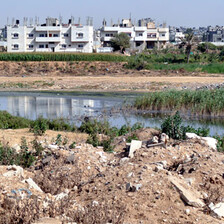The Electronic Intifada 2 February 2009
GAZA CITY, occupied Gaza Strip (IRIN) - With Gaza’s sewerage system on the verge of collapse, a top water engineer has warned of the risk of groundwater contamination in the enclave, making clean water scarcer than it already is.
Gaza is particularly vulnerable to groundwater contamination since its sandy desert soil easily absorbs water — or sewage from leaking sewage pipes. Compounding the risk is the fact that groundwater is relatively near the surface, and wells dug to access it tend to be shallow.
The aging, ill-maintained and unsafe sewerage system has suffered from an acute lack of investment. At least one waste water treatment plant at Sheikh Ajleen is also poorly sited, in a flat and sandy area, increasing the risk that sewage could seep into the water table.
Many pipes were damaged by the Israeli bombardment, meaning that when water is delivered under pressure to houses, the damaged pipes suck in air and possibly sewage, according to Majed Ghannam, the water quality manager at the Coastal Municipalities Water Utility (CMWU), Gaza’s water utility.
“The most dangerous thing is the contamination of drinking water with sewage. We need an international organization like the World Health Organization to investigate the matter,” said Monther Shoblak, the CMWU director-general.
Repairs hampered
“Eight main water artesian wells were either fully or partially destroyed during the [Israeli] bombardments,” Shoblak said.
But repair work is hampered by import bans. Israel has banned imports of items such as pipes, saying they may be used for making bombs. The CMWU was also not able to import excavators, heavy vehicles, and other specialist equipment. During the Israeli offensive virtually no repair work could be carried out, Shoblak said, adding, “Eight repair workers were killed in the Israeli attacks.”
Nevertheless, CMWU has been doing what it can, according to the latest update by the UN Office for the Coordination of Humanitarian Affairs (OCHA).
On 21 January, CMWU started emergency repairs to a group of wells and pipelines in Gaza City and northern Gaza, including Sheikh Ajleen No. 5 well, Ghabin well in Beit Lahiya, and al-Zohour well in Jabaliya. Technical teams are currently working on Civil Administration area wells (along Salah al-Din Road east of Jabaliya and north of Gaza City) and Khadija well in Beit Hanoun.
Sheikh Ajleen/Gaza City Wastewater Treatment Plant was rehabilitated on 25 January, Shoblak said.
Distribution of drinking water
Jon Bugge from Save the Children’s office in Ramallah told IRIN “Children are especially vulnerable to illness in situations of displacement and poor sanitation. According to the UN as of 18 January approximately 400,000 people, among them 224,000 children, were still without running water. We are awaiting the findings of the rapid assessment currently taking place in Gaza for more accurate information.”
According to an OCHA update for 26-27 January, “UNICEF warns that a continued shortage of drinking water and overflowing sewage in residential areas poses serious public health risks.”
Since 17 January Oxfam has been distributing an average of 10 liters of chlorinated drinking water to 30,000-40,000 people per day, mainly in Gaza City and northern Gaza. Between 12 and 20 January, the Australian Conservation Foundation (ACF) distributed 25 liters of water per person per day for a period of five days to 6,988 people in Gaza City, Beach refugee camp and Jabaliya refugee camp.
CMWU offered vehicles to transport water from the desalination station of Deir al-Balah, central Gaza, to Izbat Abed Rabu, in the north, Shoblak said.
This item comes to you via IRIN, a UN humanitarian news and information service, but may not necessarily reflect the views of the United Nations or its agencies. All IRIN material may be reposted or reprinted free-of-charge; refer to the copyright page for conditions of use. IRIN is a project of the UN Office for the Coordination of Humanitarian Affairs.


